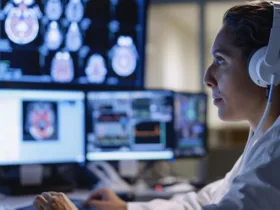Recent breakthroughs in artificial intelligence (AI) have shown promise in revolutionizing Breast Cancer Screening, significantly improving the accuracy of screening procedures. A recent study revealed that AI integration into mammography screening can improve the accuracy of detecting breast cancer by over 17%, a substantial advancement in medical technology. This AI-powered improvement in breast cancer screening could ultimately lead to more effective early detection, better treatment outcomes, and more personalized care for patients.
The Study and Its Findings
The study, which was conducted across several European countries, focused on the application of AI in screening mammograms. The researchers aimed to assess how AI could assist radiologists in identifying breast cancer more accurately, reducing false positives, and improving overall efficiency. One of the key findings of the study was that AI, when integrated into mammogram screening, increased the detection rate of breast cancer by more than 17%, showcasing the potential of AI to enhance the capabilities of human radiologists.
In addition to improving the accuracy of cancer detection, AI was shown to reduce recall rates—situations where patients are called back for additional imaging after an initial screening. False positives, which lead to unnecessary anxiety for patients and additional testing, were also reduced significantly through AI’s ability to better differentiate between malignant and benign tissue. The study demonstrated that AI can analyze mammogram images with a high degree of precision, identifying even the most subtle patterns that may be missed by the human eye.
The Benefits of AI in Breast Cancer Screening
Enhanced Detection Rates
One of the primary benefits of AI integration into breast cancer screening is its ability to increase detection rates. AI algorithms have been trained on massive datasets of mammogram images, enabling them to recognize patterns associated with early-stage breast cancer that might not be immediately visible to a radiologist. By processing mammograms with a level of detail that exceeds human capability, AI can identify potential tumors with remarkable accuracy, ensuring that more cancers are detected in their earliest stages.
Early detection is crucial in the fight against breast cancer, as it can significantly improve the chances of successful treatment and reduce the need for more aggressive interventions. With AI’s ability to pinpoint subtle changes in breast tissue, the technology can help radiologists detect cancer at a stage where it is still treatable, leading to better patient outcomes overall.
Reduced False Positives
False positives, where mammogram results mistakenly suggest the presence of cancer, have long been a challenge in breast cancer screening. These false alarms lead to unnecessary follow-up procedures such as biopsies, ultrasounds, and additional imaging, which can cause unnecessary stress for patients, increase healthcare costs, and tie up medical resources. AI’s ability to improve the accuracy of mammogram interpretation has the potential to dramatically reduce false positive rates.
By using sophisticated algorithms to distinguish between benign conditions and malignant tumors, AI helps to ensure that only those with a genuine need for further investigation are recalled for additional testing. This means fewer women will have to undergo unnecessary biopsies or additional imaging tests, reducing healthcare costs and patient anxiety. Furthermore, reducing false positives also alleviates the strain on healthcare systems, allowing radiologists and medical professionals to focus on the most critical cases.
Improved Efficiency
AI can process large volumes of mammogram images more quickly than human radiologists, which could lead to significant improvements in the efficiency of breast cancer screening programs. Radiologists often face overwhelming workloads, particularly in large-scale screening programs, where thousands of mammograms need to be reviewed in a short period. By assisting with image analysis, AI allows radiologists to focus on the most challenging cases, improving their efficiency and helping them manage their workload more effectively.
Moreover, AI’s ability to quickly analyze images means that screening results can be delivered faster, reducing waiting times for patients and leading to quicker diagnoses. This could also accelerate the overall process of treatment, ensuring that patients receive timely interventions when necessary.
Challenges and Considerations in AI Integration
While the study’s results are promising, there are still several challenges that need to be addressed in the integration of AI into breast cancer screening. These challenges involve data quality, the clinical integration of AI tools, and regulatory concerns.
Data Quality and Diversity
AI models are only as good as the data they are trained on. For AI to be effective in mammography screening, it requires large, diverse datasets that accurately represent a range of patient demographics, including age, ethnicity, breast density, and other factors that can influence breast cancer risk. Without sufficient diversity in the data, AI models could potentially introduce biases, leading to less accurate results for certain populations.
For instance, if an AI model is primarily trained on images from one demographic group, it might struggle to accurately interpret mammograms from patients outside of that group. To ensure fairness and effectiveness, AI models must be trained on a comprehensive dataset that captures the varied characteristics of breast tissue across different groups. This would help improve the performance of AI systems for all women, irrespective of their background.
Clinical Integration
Integrating AI into clinical practice is not a simple task. The implementation of AI tools in healthcare systems requires careful planning and coordination with existing infrastructure. Radiologists and healthcare providers need to be trained to work with AI tools effectively, understanding how to incorporate AI-generated results into their diagnostic processes. This could involve adapting workflows and ensuring that AI tools complement, rather than replace, the expertise of human radiologists.
Additionally, healthcare systems must validate AI models to ensure they perform reliably in real-world settings. While AI might perform well in controlled studies, it needs to be tested extensively in clinical environments to confirm its effectiveness and safety in a variety of situations. This involves rigorous testing and regulatory approvals to ensure that AI applications meet medical standards and guidelines.
Regulatory and Ethical Issues
The deployment of AI in medical diagnostics raises important regulatory and ethical concerns. AI tools must comply with stringent regulations designed to protect patient safety, data privacy, and the overall integrity of the healthcare system. Regulatory bodies like the U.S. Food and Drug Administration (FDA) and the European Medicines Agency (EMA) must assess AI tools before they can be used in clinical practice, ensuring that these systems meet the necessary safety and efficacy standards.
Furthermore, the use of AI in healthcare raises ethical questions about the role of machines in decision-making. While AI can assist radiologists in interpreting mammograms, it is crucial that human professionals remain in the loop when it comes to making critical healthcare decisions. Ensuring that AI serves as a tool for enhancing human decision-making rather than replacing it is an important ethical consideration.
The Future of AI in Breast Cancer Screening
The study’s findings signal a new era in breast cancer detection, one where AI plays a pivotal role in improving diagnostic accuracy and reducing errors. As AI technology continues to evolve, its potential applications in healthcare are expected to expand. In the case of breast cancer, AI could contribute not only to screening but also to personalized treatment strategies, monitoring disease progression, and improving patient outcomes.
Ongoing research and development are expected to refine AI models, making them even more accurate and efficient in detecting breast cancer. The future could see AI tools that are even more adept at identifying early-stage cancers and distinguishing between benign and malignant findings. Additionally, as AI systems continue to evolve, they may be used in conjunction with other diagnostic tools, such as genetic testing, to provide more comprehensive and precise assessments of a patient’s health.
Ultimately, AI’s role in breast cancer detection represents a transformative shift in how healthcare professionals approach diagnosis and treatment. With the right infrastructure, training, and regulatory oversight, AI has the potential to make breast cancer screening more accessible, accurate, and efficient, saving lives and improving the quality of care for patients worldwide.







